Synopsis: Travelled by bus from Exeter for walk Whiddon Down to Castle Drogo (NT). Easy walking through superb scenery. The gardens at Castle Drogo were spectacular. A brief castle visit included.
Inspiration for this walk came to me upon discovering how useful the Stagecoach ‘6’ bus route was to me when used on my 17 May 2018 - Walk: East Week, to Throwleigh, and then Cosdon Beacon (9.3 Miles) [My post on Blogger]. This bus route skirts Dartmoor, is a rapid journey, and what’s more, can be used on an Exeter Day Rider Plus ticket at great value (see details below). I’d mapped this walk route sometime previously and had it in the can ready for use once the opportunity arose, and that was to be today.
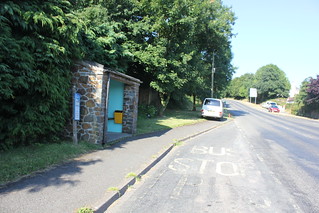
An objective for me today was to explore a length of the River Teign just above Castle Drogo (NT) which, rather surprisingly considering how many times I’d visited the lower Teign Gorge [National Trust] area, I’d not previously explored. My bus drop-off was at Whiddon Down, which I reached at 08:40 (50 minute journey). The countryside on the route out looked summery, but parched. This early in the day, the air was refreshing, although already warming fast.
Initially the walk was largely along quiet country lanes, with excellent views out to Dartmoor, not far in the distance. I followed a public footpath across a field to reach the tiny village of Murchington. From here the path dropped into trees to pick up the course of a tributary that led me down to the River Teign at Chagford Bridge, not entirely surprisingly, near to the village of Chagford, which I did not enter today.
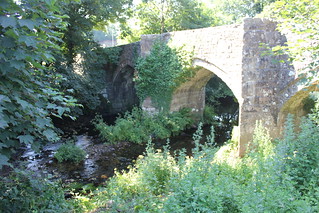
The Chagford Bridge we see today is thought to be 16th century. A bridge was mentioned at this crossing in 1224. Countless numbers of people have passed this way through the ages. The bridge is quite narrow, so its safe to say coaches won’t be crossing here.
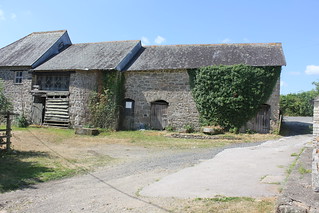
Half-way between Chagford Bridge and Dogmarsh Bridge there’s a short stretch of lane walking until Rushford Mill [Legendary Dartmoor] is reached. There are some lovely old postcards of Rushford Mill as it once was on the Legendary Dartmoor web site (follow the link to view).
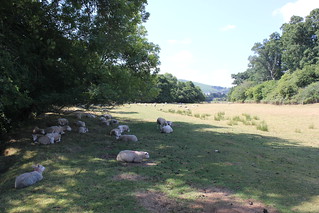
From Chagford Bridge, all the way to the footbridge over the River Teign just below Hunter’s Tor, the walking was lovely and easy, never that far from the course of the river. Occasionally there was a little shade on offer, something much appreciated by the sheep I passed, who seemed to be suffering rather from the heat. They were very relaxed about me wandering close by, hardly bothering to shift, which isn’t typical behaviour, as normally they’re very skittish.
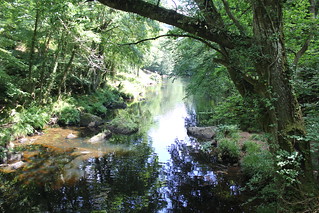
The footbridge below Hunter’s Tor marks the western end of the Teign Gorge, with Fingle Bridge at the eastern end. It’s a lovely spot, one of my favourites. The tree cover in the steeply sided gorge creates a lovely cool light, a welcome contrast to the bright heat of the day. Even after this hot spell, there was a good flow of water in the river. The fish were however finding it too warm, and occasionally jumped for air.
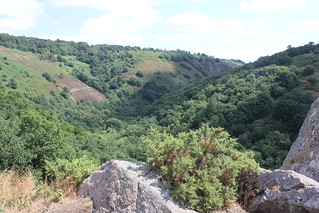
My chosen walk route from here was straight up Hunter’s Tor, which is quite steep, and a bit of a scramble. There’s an easier gentle track should that be more suitable. The views from Hunter’s Tor are a treat. In one direction one looks out to Dartmoor, where I was walking in May of this year (link above). In the other direction I looked along the Teign Gorge. And a short distance away, slightly above me, stood Castle Drogo.
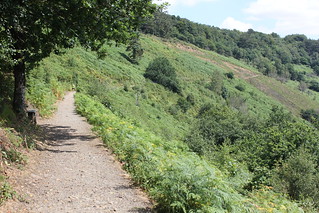
My objective now was lunch in the gardens of Castle Drogo. I followed what is named Hunter’s Path, which follows the contours of the hillside to a point just below Castle Drogo reception. As I entered (I’m a member of the National Trust), I enquired about the immense conservation project, now in its sixth year. Apparently it is well advanced, and completion is expected later this year. I sought out a shady bench in the formal garden upon which to eat my picnic lunch.
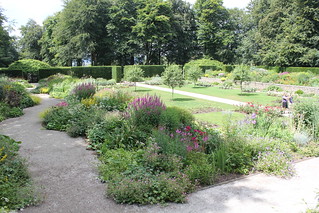
I could see from where I sat eating my lunch that the gardens at Castle Drogo were looking amazing. I do love gardens, and now was the zenith of their prime season. I took a stroll. What has been achieved here at the centre of the formal garden of Castle Drogo is great swathes of colour swatches at varying heights and set against a perimeter of dark yew hedging. In the centre is a lawn rigidly interspersed with rose beds.
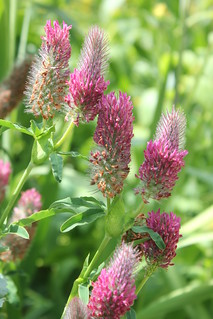
A less formal woodland garden leads off above the formal garden, and above that is the croquet lawn. A gardener’s hut is located here, and inside are displays identifying many of the plants to be found here, and old photos showing how the garden was planned and developed. There is a blue theme to much of the planting. But, just to be perverse, as is my wont, I'm choosing this Red Feather Clover as my plant of the day. Who'd have thought clover could look so spectacular?
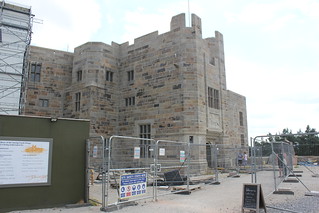
For the duration of the conservation work on Castle Drogo, now in its sixth and final year, I had been mostly bypassing the building, focussing on the gardens and the surrounding landscape, which has so much to offer. The works on the castle have been very extensive, effectively a dismantling and rebuilding, affecting both the exterior and interior of the castle, somewhat negatively impacting the experience of a visit. Today I opted for a brief castle visit.
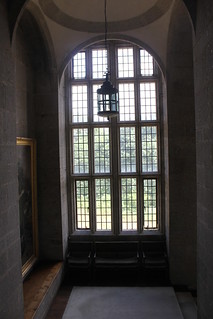
One of the features I like about the castle is its windows. They are very large and elegant. I talked to a steward about them. They have been taken out, re-glazed, and set back in their frames, in the expectation that they will now provide a more effective barrier against the driving rains encroaching from Dartmoor. They are, apparently, made of brass, which accounts for the excellent working condition of them, even after all this time. The windows must surely have cost a packet at the time of initial construction.
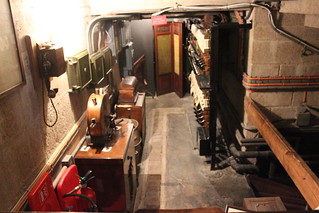
I had a particular wish to seek out the old switch room. Castle Drogo had some modern (for its time) creature comforts installed, such as electricity, central heating, and even a shower (see: Castle Drogo (NT) 024 [My photo on Flickr]). In October of last year, I passed the hydroelectric installation, recently refurbished by the National Trust (see: 14 October 2017 - Walk: Castle Drogo (NT) to Cheriton Bishop (9.4 Miles) [My post on Blogger]). An almost inaudible hum from the Hydro Turbine House [National Trust] on the river bank could be heard emanating from it. New cables could be seen feeding electricity back up the hillside to the castle, capable of supplying half of its energy requirement. And here in the castle itself, the old Switch Room complete with its original installation can be seen still in place. It’s a little time-warp, and yet how modern to have been so sustainable back then.
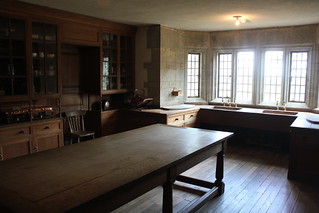
Castle Drogo is a wildly romantic and delightful enigma. What were they thinking? building a ‘castle’ at this time. A case of, ‘We’ve got the money, let’s have fun.’ And they got so much right in their blend of the old and the new. What a fabulous location! Self-sufficient in electricity, with telephones, showers and central heating. Designed by a leading architect of the age. Added to this, a garden of fine taste. It’s my belief that only now has Castle Drogo come of age. The technologies of the time of construction were not sufficient to match the imagining. Today we have the required technology. Put together well the dream and the technology, and what you get is the Castle Drogo that we have today. A conservation project of breath-taking scale and complexity; I applaud the National Trust for their determination and nerve. The result will assuredly please countless generations. It’s comforting to think so much of our heritage is in such safe hands.
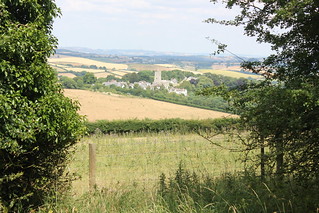
After my visit to the castle, I checked the time, it was now 14:20, and considered what bus I might catch. It would have be a rush to catch the 15:30, and I wasn’t prepared to rush on as hot a day as today. I settled upon a leisurely pace, with the aim of catching the 16:59 bus. I relaxed on a garden bench, had a drink, took a couple more circuits around the garden paths, and dawdled in the shop. By 15:00 I was strolling down the castle drive.
I walked down a lane marked ‘Road Closed’ in the hope I could pass. A new fibre optic cable was being laid in the road. This is the bus route I used in October last year, so I’m not sure what’s happening with that just now. I picked up a public footpath which connected me with another lane. It was a short walk, over a bridge on the Fingle Stream just below Ford House, and on an upward climb to where I intersected with my bus route.
By 15:40 I had reached my bus stop, Ford House Turn, which meant I had a 1hr 20mins wait for my bus. I had overestimated the required walk time. I found some shade under a tree and caught up with the news on my mobile phone. My bus was punctual and the journey home efficient. The perfect end to a perfect day’s walking.
Walk Statistics:
Total Distance: 16.55 km / 10.3 miles
Moving Time: 5hrs 46min
Stopped Time: 30min
Total Ascent: 357 metres
Maximum Elevation: 278 metres
Buses: S, 6A, 6 & D
Exeter Dayrider Plus bus ticket: £6.00 (purchased on first bus of the day)
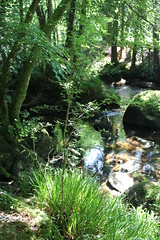
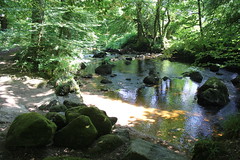
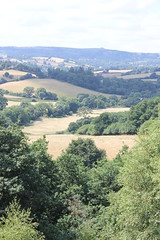
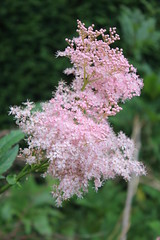
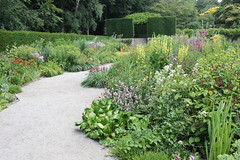
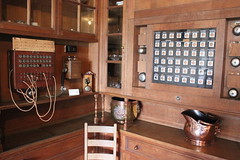
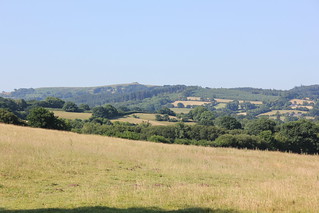
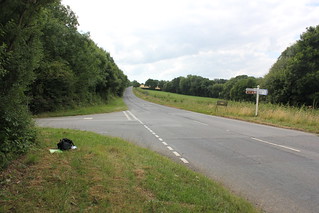
No comments:
Post a Comment